Formation of Contract Law: Offer, Acceptance, Consideration, Clause
VerifiedAdded on 2023/06/11
|8
|2444
|260
Essay
AI Summary
This essay provides a comprehensive overview of the fundamental elements of contract law in the UK, focusing on offer, acceptance, consideration, and exclusion clauses. It begins by defining a contract and outlining the essential requirements for its formation, including the rules governing offers, invitations to treat, counter-offers, and the communication of acceptance, supported by relevant case law such as Carlill vs. Carbolic Smoke Ball Company and Hyde vs. Wrench. The essay then delves into the concept of consideration, explaining its importance in making a promise binding and illustrating its application with an example related to a car servicing arrangement. Furthermore, it discusses the intention to create legal relations, contrasting commercial agreements with domestic arrangements using the case of Balfour vs. Balfour. Finally, the essay examines exclusion clauses, their purpose in limiting liability, and the legal constraints imposed by the Unfair Contract Terms Act 1997, referencing the Goodlife Foods Ltd v Hall Fire Protection Ltd case to highlight the importance of clear drafting. The document is contributed by a student and available on Desklib, a platform offering study tools and resources for students.
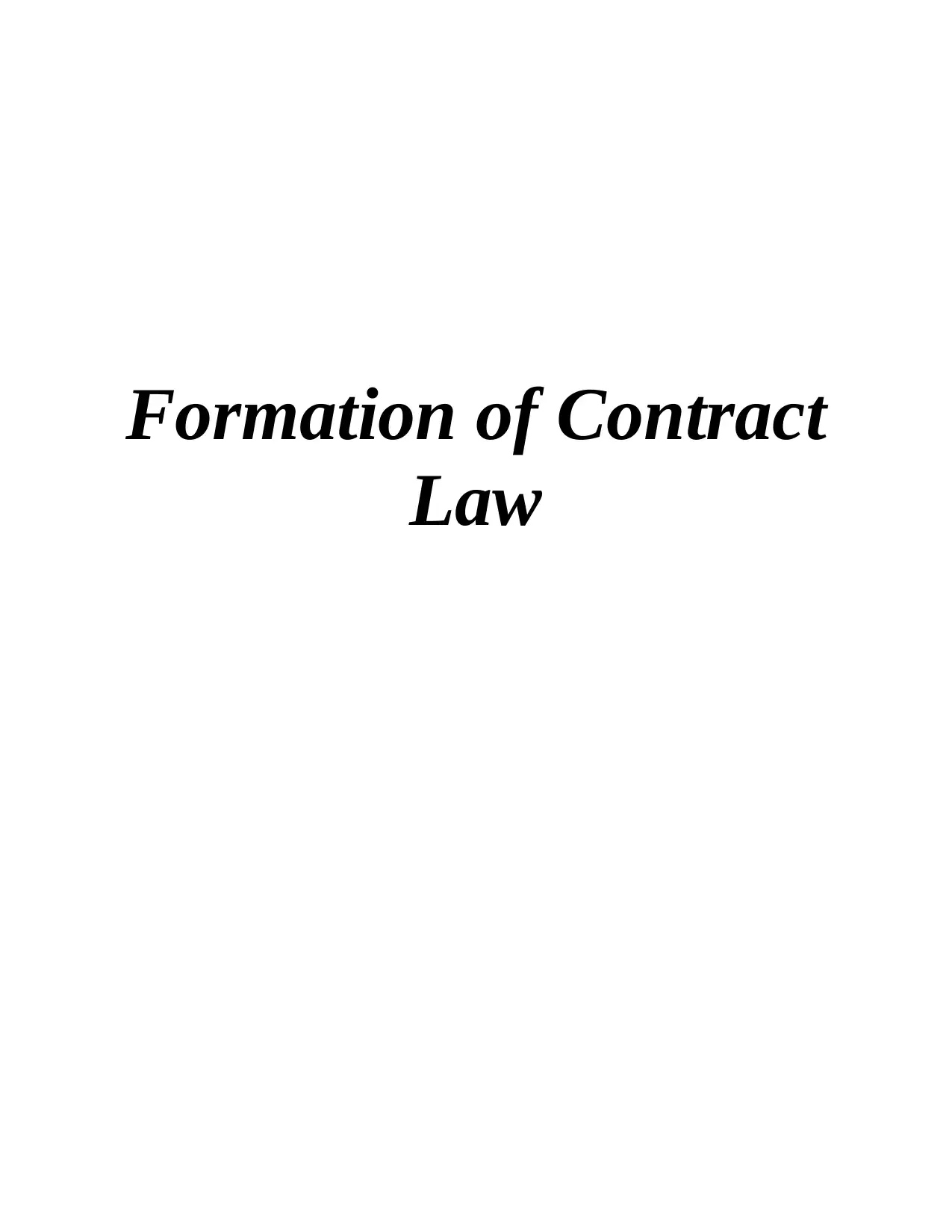
Formation of Contract
Law
Law
Paraphrase This Document
Need a fresh take? Get an instant paraphrase of this document with our AI Paraphraser
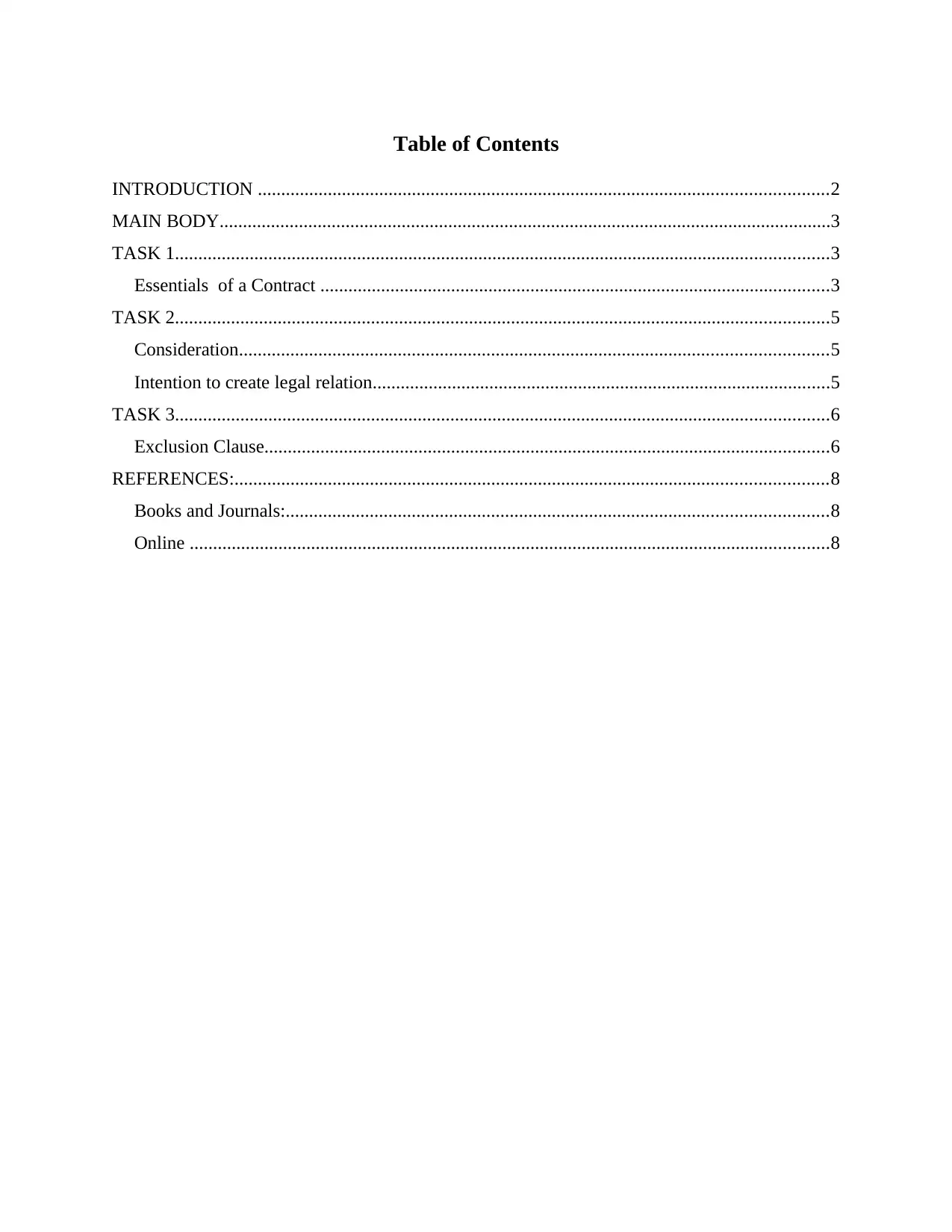
Table of Contents
INTRODUCTION ..........................................................................................................................2
MAIN BODY...................................................................................................................................3
TASK 1............................................................................................................................................3
Essentials of a Contract .............................................................................................................3
TASK 2............................................................................................................................................5
Consideration..............................................................................................................................5
Intention to create legal relation..................................................................................................5
TASK 3............................................................................................................................................6
Exclusion Clause.........................................................................................................................6
REFERENCES:...............................................................................................................................8
Books and Journals:....................................................................................................................8
Online .........................................................................................................................................8
INTRODUCTION ..........................................................................................................................2
MAIN BODY...................................................................................................................................3
TASK 1............................................................................................................................................3
Essentials of a Contract .............................................................................................................3
TASK 2............................................................................................................................................5
Consideration..............................................................................................................................5
Intention to create legal relation..................................................................................................5
TASK 3............................................................................................................................................6
Exclusion Clause.........................................................................................................................6
REFERENCES:...............................................................................................................................8
Books and Journals:....................................................................................................................8
Online .........................................................................................................................................8
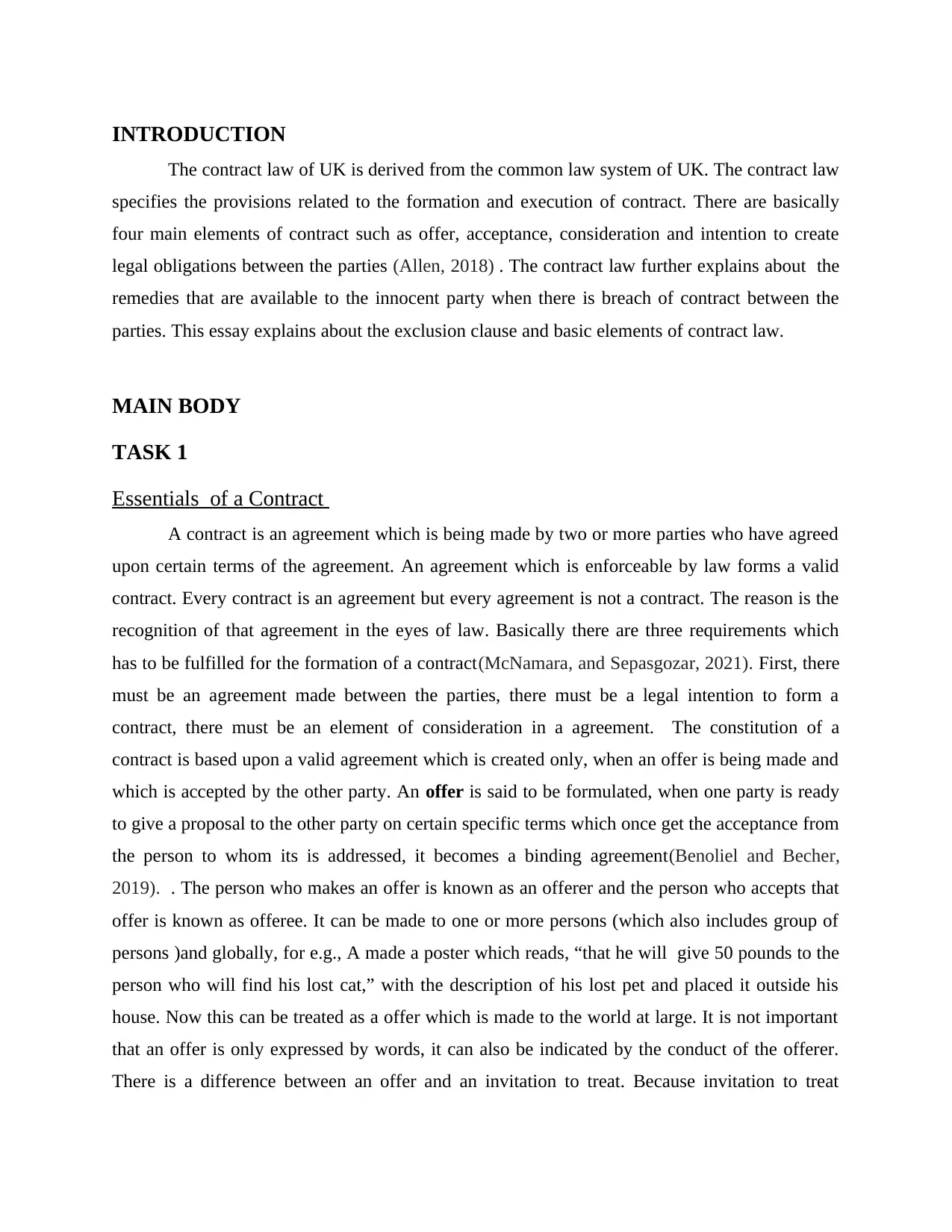
INTRODUCTION
The contract law of UK is derived from the common law system of UK. The contract law
specifies the provisions related to the formation and execution of contract. There are basically
four main elements of contract such as offer, acceptance, consideration and intention to create
legal obligations between the parties (Allen, 2018) . The contract law further explains about the
remedies that are available to the innocent party when there is breach of contract between the
parties. This essay explains about the exclusion clause and basic elements of contract law.
MAIN BODY
TASK 1
Essentials of a Contract
A contract is an agreement which is being made by two or more parties who have agreed
upon certain terms of the agreement. An agreement which is enforceable by law forms a valid
contract. Every contract is an agreement but every agreement is not a contract. The reason is the
recognition of that agreement in the eyes of law. Basically there are three requirements which
has to be fulfilled for the formation of a contract(McNamara, and Sepasgozar, 2021). First, there
must be an agreement made between the parties, there must be a legal intention to form a
contract, there must be an element of consideration in a agreement. The constitution of a
contract is based upon a valid agreement which is created only, when an offer is being made and
which is accepted by the other party. An offer is said to be formulated, when one party is ready
to give a proposal to the other party on certain specific terms which once get the acceptance from
the person to whom its is addressed, it becomes a binding agreement(Benoliel and Becher,
2019). . The person who makes an offer is known as an offerer and the person who accepts that
offer is known as offeree. It can be made to one or more persons (which also includes group of
persons )and globally, for e.g., A made a poster which reads, “that he will give 50 pounds to the
person who will find his lost cat,” with the description of his lost pet and placed it outside his
house. Now this can be treated as a offer which is made to the world at large. It is not important
that an offer is only expressed by words, it can also be indicated by the conduct of the offerer.
There is a difference between an offer and an invitation to treat. Because invitation to treat
The contract law of UK is derived from the common law system of UK. The contract law
specifies the provisions related to the formation and execution of contract. There are basically
four main elements of contract such as offer, acceptance, consideration and intention to create
legal obligations between the parties (Allen, 2018) . The contract law further explains about the
remedies that are available to the innocent party when there is breach of contract between the
parties. This essay explains about the exclusion clause and basic elements of contract law.
MAIN BODY
TASK 1
Essentials of a Contract
A contract is an agreement which is being made by two or more parties who have agreed
upon certain terms of the agreement. An agreement which is enforceable by law forms a valid
contract. Every contract is an agreement but every agreement is not a contract. The reason is the
recognition of that agreement in the eyes of law. Basically there are three requirements which
has to be fulfilled for the formation of a contract(McNamara, and Sepasgozar, 2021). First, there
must be an agreement made between the parties, there must be a legal intention to form a
contract, there must be an element of consideration in a agreement. The constitution of a
contract is based upon a valid agreement which is created only, when an offer is being made and
which is accepted by the other party. An offer is said to be formulated, when one party is ready
to give a proposal to the other party on certain specific terms which once get the acceptance from
the person to whom its is addressed, it becomes a binding agreement(Benoliel and Becher,
2019). . The person who makes an offer is known as an offerer and the person who accepts that
offer is known as offeree. It can be made to one or more persons (which also includes group of
persons )and globally, for e.g., A made a poster which reads, “that he will give 50 pounds to the
person who will find his lost cat,” with the description of his lost pet and placed it outside his
house. Now this can be treated as a offer which is made to the world at large. It is not important
that an offer is only expressed by words, it can also be indicated by the conduct of the offerer.
There is a difference between an offer and an invitation to treat. Because invitation to treat
⊘ This is a preview!⊘
Do you want full access?
Subscribe today to unlock all pages.

Trusted by 1+ million students worldwide
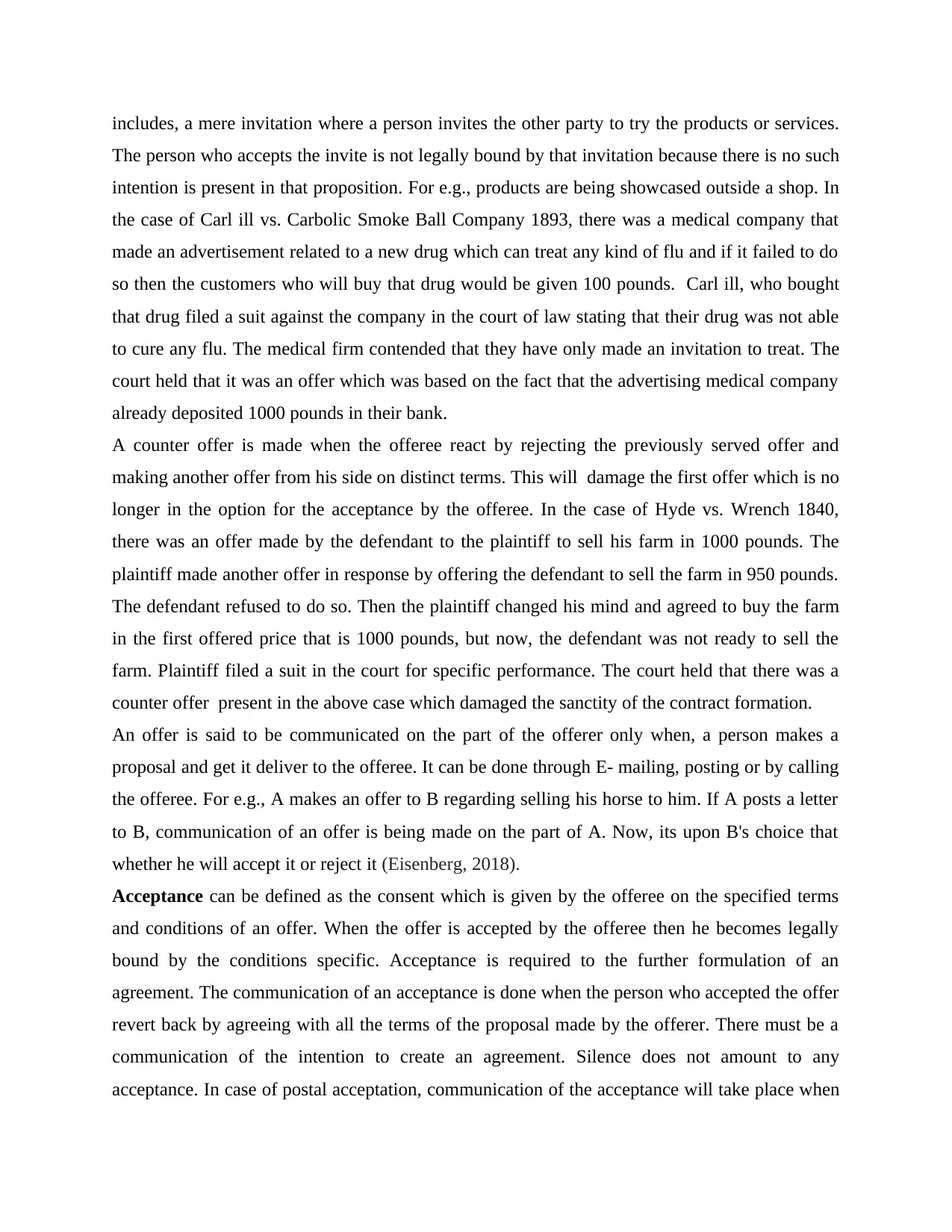
includes, a mere invitation where a person invites the other party to try the products or services.
The person who accepts the invite is not legally bound by that invitation because there is no such
intention is present in that proposition. For e.g., products are being showcased outside a shop. In
the case of Carl ill vs. Carbolic Smoke Ball Company 1893, there was a medical company that
made an advertisement related to a new drug which can treat any kind of flu and if it failed to do
so then the customers who will buy that drug would be given 100 pounds. Carl ill, who bought
that drug filed a suit against the company in the court of law stating that their drug was not able
to cure any flu. The medical firm contended that they have only made an invitation to treat. The
court held that it was an offer which was based on the fact that the advertising medical company
already deposited 1000 pounds in their bank.
A counter offer is made when the offeree react by rejecting the previously served offer and
making another offer from his side on distinct terms. This will damage the first offer which is no
longer in the option for the acceptance by the offeree. In the case of Hyde vs. Wrench 1840,
there was an offer made by the defendant to the plaintiff to sell his farm in 1000 pounds. The
plaintiff made another offer in response by offering the defendant to sell the farm in 950 pounds.
The defendant refused to do so. Then the plaintiff changed his mind and agreed to buy the farm
in the first offered price that is 1000 pounds, but now, the defendant was not ready to sell the
farm. Plaintiff filed a suit in the court for specific performance. The court held that there was a
counter offer present in the above case which damaged the sanctity of the contract formation.
An offer is said to be communicated on the part of the offerer only when, a person makes a
proposal and get it deliver to the offeree. It can be done through E- mailing, posting or by calling
the offeree. For e.g., A makes an offer to B regarding selling his horse to him. If A posts a letter
to B, communication of an offer is being made on the part of A. Now, its upon B's choice that
whether he will accept it or reject it (Eisenberg, 2018).
Acceptance can be defined as the consent which is given by the offeree on the specified terms
and conditions of an offer. When the offer is accepted by the offeree then he becomes legally
bound by the conditions specific. Acceptance is required to the further formulation of an
agreement. The communication of an acceptance is done when the person who accepted the offer
revert back by agreeing with all the terms of the proposal made by the offerer. There must be a
communication of the intention to create an agreement. Silence does not amount to any
acceptance. In case of postal acceptation, communication of the acceptance will take place when
The person who accepts the invite is not legally bound by that invitation because there is no such
intention is present in that proposition. For e.g., products are being showcased outside a shop. In
the case of Carl ill vs. Carbolic Smoke Ball Company 1893, there was a medical company that
made an advertisement related to a new drug which can treat any kind of flu and if it failed to do
so then the customers who will buy that drug would be given 100 pounds. Carl ill, who bought
that drug filed a suit against the company in the court of law stating that their drug was not able
to cure any flu. The medical firm contended that they have only made an invitation to treat. The
court held that it was an offer which was based on the fact that the advertising medical company
already deposited 1000 pounds in their bank.
A counter offer is made when the offeree react by rejecting the previously served offer and
making another offer from his side on distinct terms. This will damage the first offer which is no
longer in the option for the acceptance by the offeree. In the case of Hyde vs. Wrench 1840,
there was an offer made by the defendant to the plaintiff to sell his farm in 1000 pounds. The
plaintiff made another offer in response by offering the defendant to sell the farm in 950 pounds.
The defendant refused to do so. Then the plaintiff changed his mind and agreed to buy the farm
in the first offered price that is 1000 pounds, but now, the defendant was not ready to sell the
farm. Plaintiff filed a suit in the court for specific performance. The court held that there was a
counter offer present in the above case which damaged the sanctity of the contract formation.
An offer is said to be communicated on the part of the offerer only when, a person makes a
proposal and get it deliver to the offeree. It can be done through E- mailing, posting or by calling
the offeree. For e.g., A makes an offer to B regarding selling his horse to him. If A posts a letter
to B, communication of an offer is being made on the part of A. Now, its upon B's choice that
whether he will accept it or reject it (Eisenberg, 2018).
Acceptance can be defined as the consent which is given by the offeree on the specified terms
and conditions of an offer. When the offer is accepted by the offeree then he becomes legally
bound by the conditions specific. Acceptance is required to the further formulation of an
agreement. The communication of an acceptance is done when the person who accepted the offer
revert back by agreeing with all the terms of the proposal made by the offerer. There must be a
communication of the intention to create an agreement. Silence does not amount to any
acceptance. In case of postal acceptation, communication of the acceptance will take place when
Paraphrase This Document
Need a fresh take? Get an instant paraphrase of this document with our AI Paraphraser
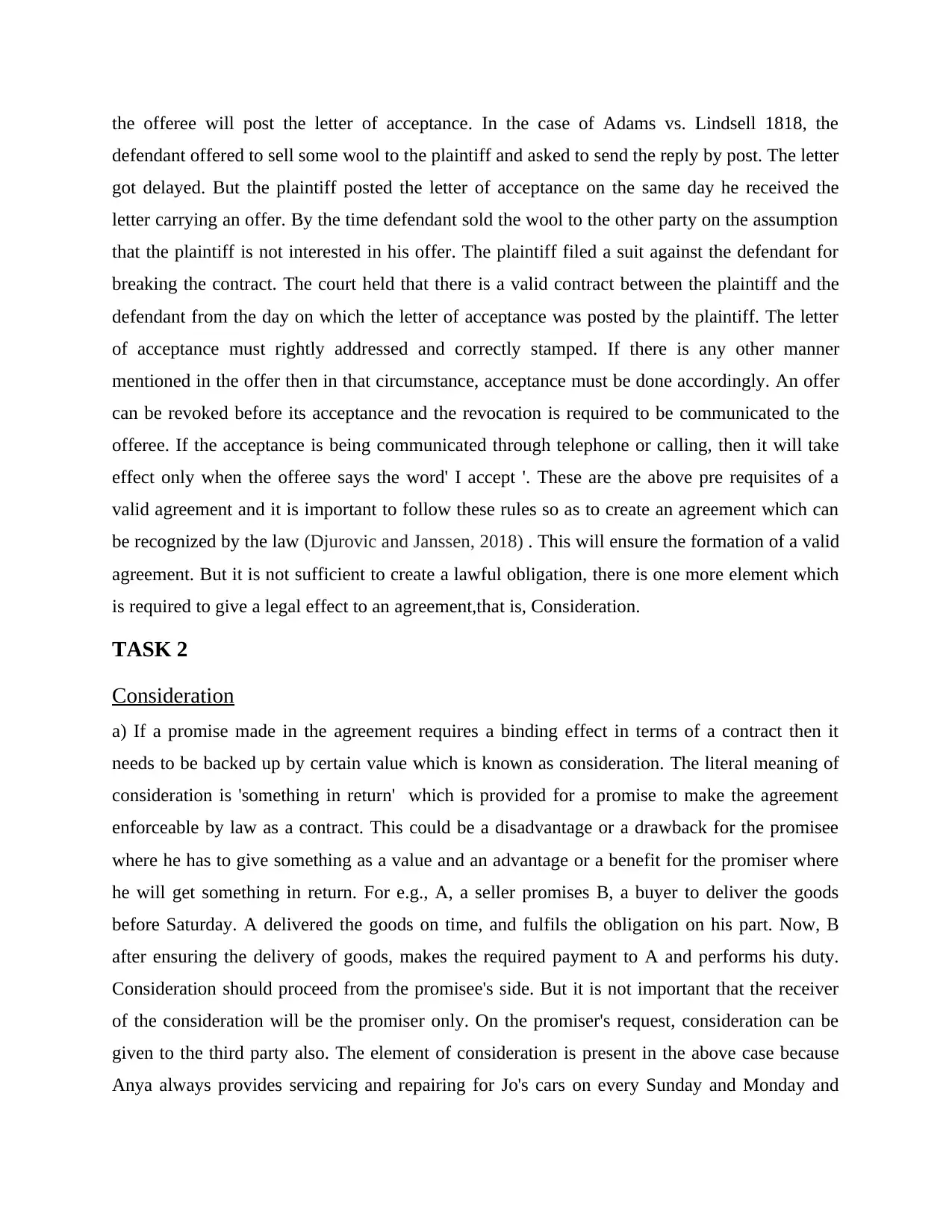
the offeree will post the letter of acceptance. In the case of Adams vs. Lindsell 1818, the
defendant offered to sell some wool to the plaintiff and asked to send the reply by post. The letter
got delayed. But the plaintiff posted the letter of acceptance on the same day he received the
letter carrying an offer. By the time defendant sold the wool to the other party on the assumption
that the plaintiff is not interested in his offer. The plaintiff filed a suit against the defendant for
breaking the contract. The court held that there is a valid contract between the plaintiff and the
defendant from the day on which the letter of acceptance was posted by the plaintiff. The letter
of acceptance must rightly addressed and correctly stamped. If there is any other manner
mentioned in the offer then in that circumstance, acceptance must be done accordingly. An offer
can be revoked before its acceptance and the revocation is required to be communicated to the
offeree. If the acceptance is being communicated through telephone or calling, then it will take
effect only when the offeree says the word' I accept '. These are the above pre requisites of a
valid agreement and it is important to follow these rules so as to create an agreement which can
be recognized by the law (Djurovic and Janssen, 2018) . This will ensure the formation of a valid
agreement. But it is not sufficient to create a lawful obligation, there is one more element which
is required to give a legal effect to an agreement,that is, Consideration.
TASK 2
Consideration
a) If a promise made in the agreement requires a binding effect in terms of a contract then it
needs to be backed up by certain value which is known as consideration. The literal meaning of
consideration is 'something in return' which is provided for a promise to make the agreement
enforceable by law as a contract. This could be a disadvantage or a drawback for the promisee
where he has to give something as a value and an advantage or a benefit for the promiser where
he will get something in return. For e.g., A, a seller promises B, a buyer to deliver the goods
before Saturday. A delivered the goods on time, and fulfils the obligation on his part. Now, B
after ensuring the delivery of goods, makes the required payment to A and performs his duty.
Consideration should proceed from the promisee's side. But it is not important that the receiver
of the consideration will be the promiser only. On the promiser's request, consideration can be
given to the third party also. The element of consideration is present in the above case because
Anya always provides servicing and repairing for Jo's cars on every Sunday and Monday and
defendant offered to sell some wool to the plaintiff and asked to send the reply by post. The letter
got delayed. But the plaintiff posted the letter of acceptance on the same day he received the
letter carrying an offer. By the time defendant sold the wool to the other party on the assumption
that the plaintiff is not interested in his offer. The plaintiff filed a suit against the defendant for
breaking the contract. The court held that there is a valid contract between the plaintiff and the
defendant from the day on which the letter of acceptance was posted by the plaintiff. The letter
of acceptance must rightly addressed and correctly stamped. If there is any other manner
mentioned in the offer then in that circumstance, acceptance must be done accordingly. An offer
can be revoked before its acceptance and the revocation is required to be communicated to the
offeree. If the acceptance is being communicated through telephone or calling, then it will take
effect only when the offeree says the word' I accept '. These are the above pre requisites of a
valid agreement and it is important to follow these rules so as to create an agreement which can
be recognized by the law (Djurovic and Janssen, 2018) . This will ensure the formation of a valid
agreement. But it is not sufficient to create a lawful obligation, there is one more element which
is required to give a legal effect to an agreement,that is, Consideration.
TASK 2
Consideration
a) If a promise made in the agreement requires a binding effect in terms of a contract then it
needs to be backed up by certain value which is known as consideration. The literal meaning of
consideration is 'something in return' which is provided for a promise to make the agreement
enforceable by law as a contract. This could be a disadvantage or a drawback for the promisee
where he has to give something as a value and an advantage or a benefit for the promiser where
he will get something in return. For e.g., A, a seller promises B, a buyer to deliver the goods
before Saturday. A delivered the goods on time, and fulfils the obligation on his part. Now, B
after ensuring the delivery of goods, makes the required payment to A and performs his duty.
Consideration should proceed from the promisee's side. But it is not important that the receiver
of the consideration will be the promiser only. On the promiser's request, consideration can be
given to the third party also. The element of consideration is present in the above case because
Anya always provides servicing and repairing for Jo's cars on every Sunday and Monday and
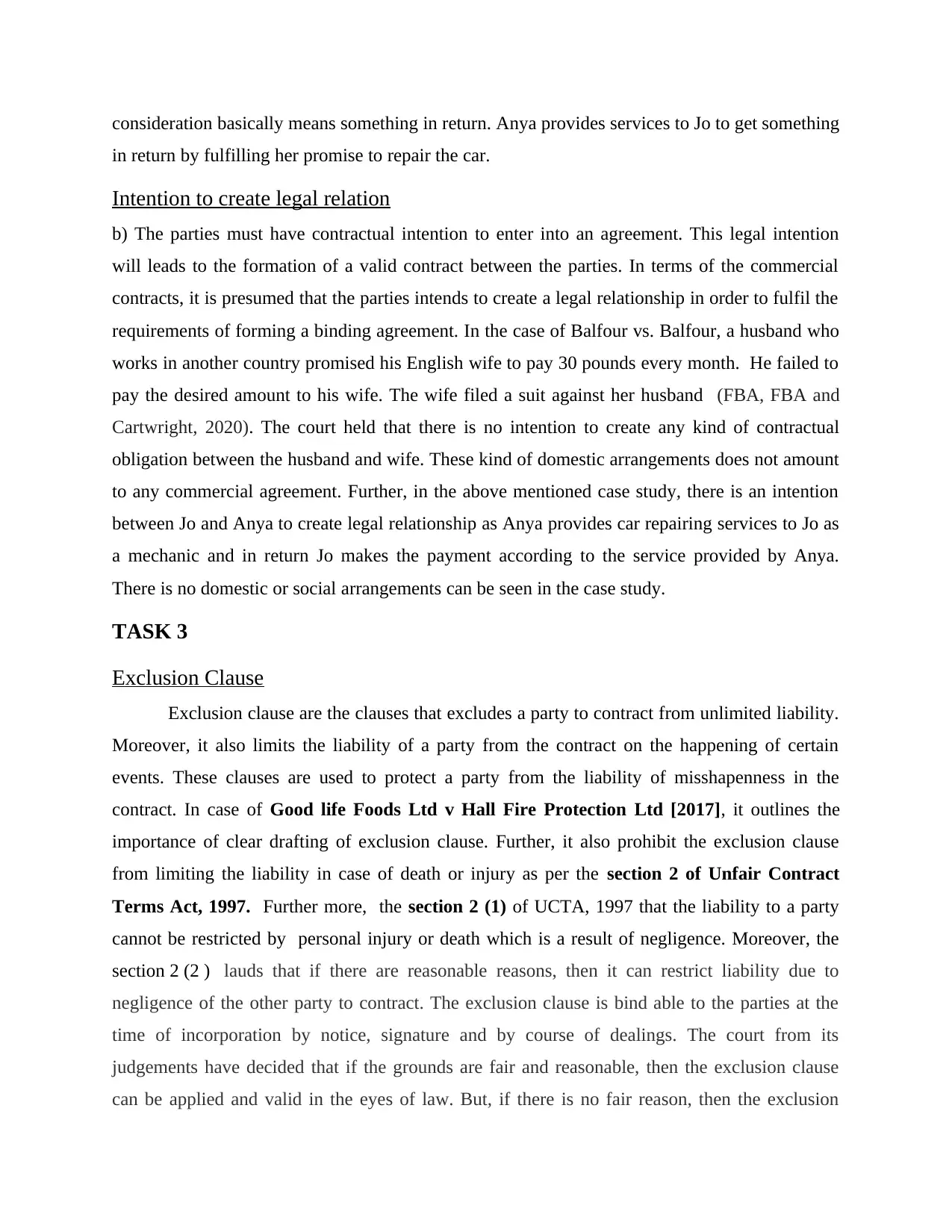
consideration basically means something in return. Anya provides services to Jo to get something
in return by fulfilling her promise to repair the car.
Intention to create legal relation
b) The parties must have contractual intention to enter into an agreement. This legal intention
will leads to the formation of a valid contract between the parties. In terms of the commercial
contracts, it is presumed that the parties intends to create a legal relationship in order to fulfil the
requirements of forming a binding agreement. In the case of Balfour vs. Balfour, a husband who
works in another country promised his English wife to pay 30 pounds every month. He failed to
pay the desired amount to his wife. The wife filed a suit against her husband (FBA, FBA and
Cartwright, 2020). The court held that there is no intention to create any kind of contractual
obligation between the husband and wife. These kind of domestic arrangements does not amount
to any commercial agreement. Further, in the above mentioned case study, there is an intention
between Jo and Anya to create legal relationship as Anya provides car repairing services to Jo as
a mechanic and in return Jo makes the payment according to the service provided by Anya.
There is no domestic or social arrangements can be seen in the case study.
TASK 3
Exclusion Clause
Exclusion clause are the clauses that excludes a party to contract from unlimited liability.
Moreover, it also limits the liability of a party from the contract on the happening of certain
events. These clauses are used to protect a party from the liability of misshapenness in the
contract. In case of Good life Foods Ltd v Hall Fire Protection Ltd [2017], it outlines the
importance of clear drafting of exclusion clause. Further, it also prohibit the exclusion clause
from limiting the liability in case of death or injury as per the section 2 of Unfair Contract
Terms Act, 1997. Further more, the section 2 (1) of UCTA, 1997 that the liability to a party
cannot be restricted by personal injury or death which is a result of negligence. Moreover, the
section 2 (2 ) lauds that if there are reasonable reasons, then it can restrict liability due to
negligence of the other party to contract. The exclusion clause is bind able to the parties at the
time of incorporation by notice, signature and by course of dealings. The court from its
judgements have decided that if the grounds are fair and reasonable, then the exclusion clause
can be applied and valid in the eyes of law. But, if there is no fair reason, then the exclusion
in return by fulfilling her promise to repair the car.
Intention to create legal relation
b) The parties must have contractual intention to enter into an agreement. This legal intention
will leads to the formation of a valid contract between the parties. In terms of the commercial
contracts, it is presumed that the parties intends to create a legal relationship in order to fulfil the
requirements of forming a binding agreement. In the case of Balfour vs. Balfour, a husband who
works in another country promised his English wife to pay 30 pounds every month. He failed to
pay the desired amount to his wife. The wife filed a suit against her husband (FBA, FBA and
Cartwright, 2020). The court held that there is no intention to create any kind of contractual
obligation between the husband and wife. These kind of domestic arrangements does not amount
to any commercial agreement. Further, in the above mentioned case study, there is an intention
between Jo and Anya to create legal relationship as Anya provides car repairing services to Jo as
a mechanic and in return Jo makes the payment according to the service provided by Anya.
There is no domestic or social arrangements can be seen in the case study.
TASK 3
Exclusion Clause
Exclusion clause are the clauses that excludes a party to contract from unlimited liability.
Moreover, it also limits the liability of a party from the contract on the happening of certain
events. These clauses are used to protect a party from the liability of misshapenness in the
contract. In case of Good life Foods Ltd v Hall Fire Protection Ltd [2017], it outlines the
importance of clear drafting of exclusion clause. Further, it also prohibit the exclusion clause
from limiting the liability in case of death or injury as per the section 2 of Unfair Contract
Terms Act, 1997. Further more, the section 2 (1) of UCTA, 1997 that the liability to a party
cannot be restricted by personal injury or death which is a result of negligence. Moreover, the
section 2 (2 ) lauds that if there are reasonable reasons, then it can restrict liability due to
negligence of the other party to contract. The exclusion clause is bind able to the parties at the
time of incorporation by notice, signature and by course of dealings. The court from its
judgements have decided that if the grounds are fair and reasonable, then the exclusion clause
can be applied and valid in the eyes of law. But, if there is no fair reason, then the exclusion
⊘ This is a preview!⊘
Do you want full access?
Subscribe today to unlock all pages.

Trusted by 1+ million students worldwide
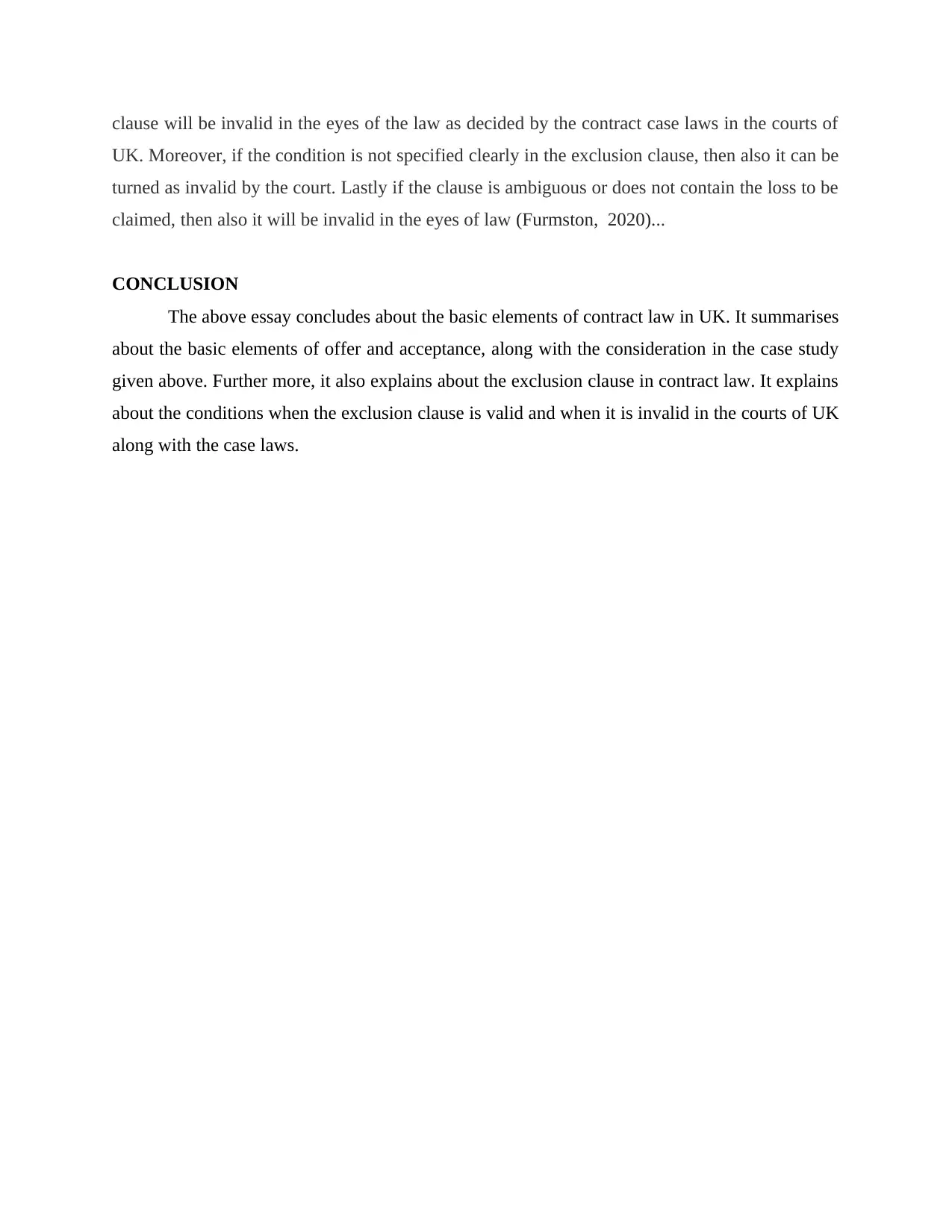
clause will be invalid in the eyes of the law as decided by the contract case laws in the courts of
UK. Moreover, if the condition is not specified clearly in the exclusion clause, then also it can be
turned as invalid by the court. Lastly if the clause is ambiguous or does not contain the loss to be
claimed, then also it will be invalid in the eyes of law (Furmston, 2020)...
CONCLUSION
The above essay concludes about the basic elements of contract law in UK. It summarises
about the basic elements of offer and acceptance, along with the consideration in the case study
given above. Further more, it also explains about the exclusion clause in contract law. It explains
about the conditions when the exclusion clause is valid and when it is invalid in the courts of UK
along with the case laws.
UK. Moreover, if the condition is not specified clearly in the exclusion clause, then also it can be
turned as invalid by the court. Lastly if the clause is ambiguous or does not contain the loss to be
claimed, then also it will be invalid in the eyes of law (Furmston, 2020)...
CONCLUSION
The above essay concludes about the basic elements of contract law in UK. It summarises
about the basic elements of offer and acceptance, along with the consideration in the case study
given above. Further more, it also explains about the exclusion clause in contract law. It explains
about the conditions when the exclusion clause is valid and when it is invalid in the courts of UK
along with the case laws.
Paraphrase This Document
Need a fresh take? Get an instant paraphrase of this document with our AI Paraphraser
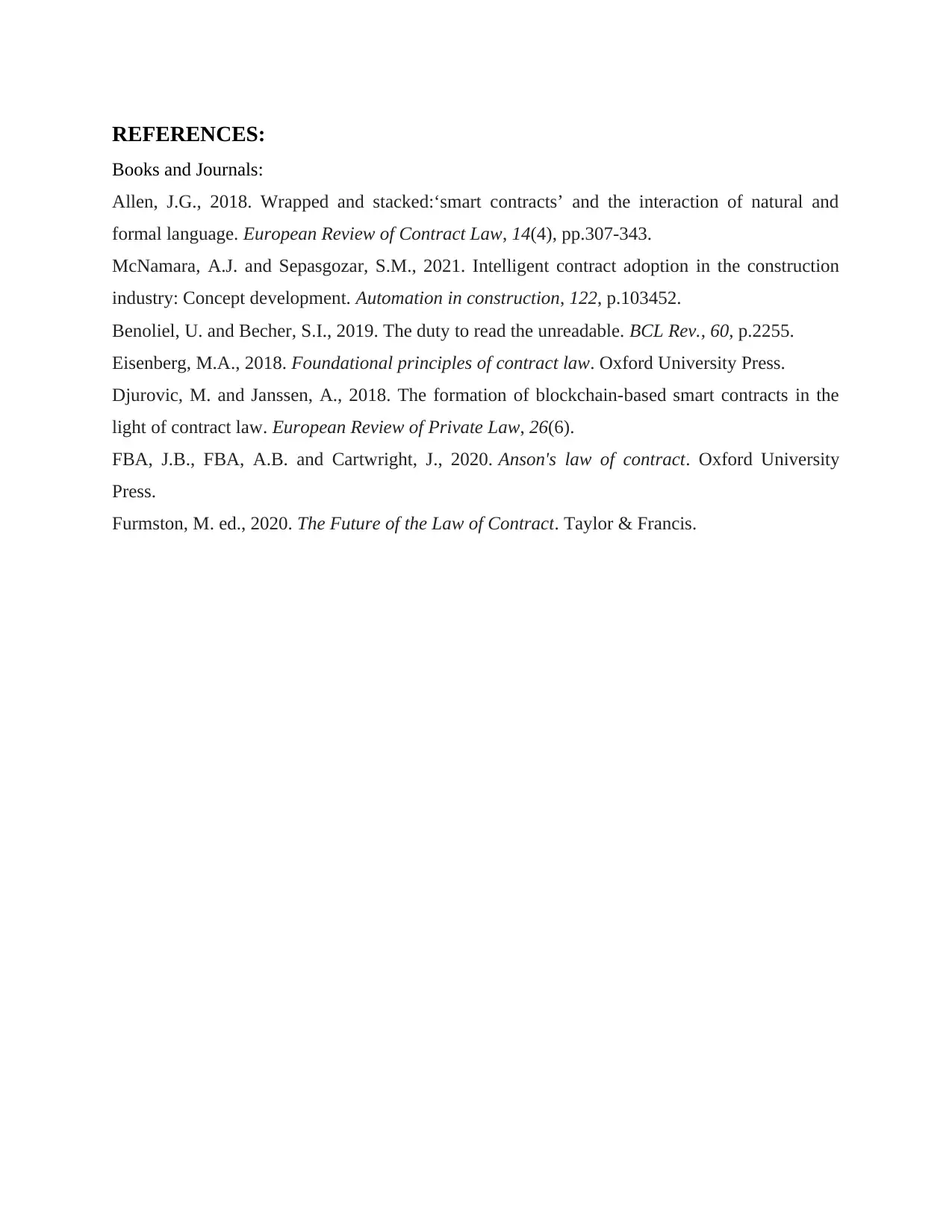
REFERENCES:
Books and Journals:
Allen, J.G., 2018. Wrapped and stacked:‘smart contracts’ and the interaction of natural and
formal language. European Review of Contract Law, 14(4), pp.307-343.
McNamara, A.J. and Sepasgozar, S.M., 2021. Intelligent contract adoption in the construction
industry: Concept development. Automation in construction, 122, p.103452.
Benoliel, U. and Becher, S.I., 2019. The duty to read the unreadable. BCL Rev., 60, p.2255.
Eisenberg, M.A., 2018. Foundational principles of contract law. Oxford University Press.
Djurovic, M. and Janssen, A., 2018. The formation of blockchain-based smart contracts in the
light of contract law. European Review of Private Law, 26(6).
FBA, J.B., FBA, A.B. and Cartwright, J., 2020. Anson's law of contract. Oxford University
Press.
Furmston, M. ed., 2020. The Future of the Law of Contract. Taylor & Francis.
Books and Journals:
Allen, J.G., 2018. Wrapped and stacked:‘smart contracts’ and the interaction of natural and
formal language. European Review of Contract Law, 14(4), pp.307-343.
McNamara, A.J. and Sepasgozar, S.M., 2021. Intelligent contract adoption in the construction
industry: Concept development. Automation in construction, 122, p.103452.
Benoliel, U. and Becher, S.I., 2019. The duty to read the unreadable. BCL Rev., 60, p.2255.
Eisenberg, M.A., 2018. Foundational principles of contract law. Oxford University Press.
Djurovic, M. and Janssen, A., 2018. The formation of blockchain-based smart contracts in the
light of contract law. European Review of Private Law, 26(6).
FBA, J.B., FBA, A.B. and Cartwright, J., 2020. Anson's law of contract. Oxford University
Press.
Furmston, M. ed., 2020. The Future of the Law of Contract. Taylor & Francis.
1 out of 8
Related Documents
Your All-in-One AI-Powered Toolkit for Academic Success.
+13062052269
info@desklib.com
Available 24*7 on WhatsApp / Email
![[object Object]](/_next/static/media/star-bottom.7253800d.svg)
Unlock your academic potential
Copyright © 2020–2025 A2Z Services. All Rights Reserved. Developed and managed by ZUCOL.





